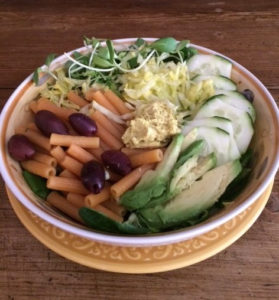When it comes to protein, I think we can all agree it is a major player in the trio of essential macronutrients. Protein is necessary for almost every function in our bodies. It can repair and rebuild muscle, provide energy and boost immunity. However, there can be some confusion about protein. How much do we actually need? Is animal protein better than plant protein? When is the best time to consume protein? All great questions so let’s see if I can answer some of them for you.
How much protein do you really need? The Recommended Dietary Allowance (RDA) is .36 grams/lb. body weight/day. This number reflects the minimum amount a relatively sedentary person needs to be healthy. For an average woman, this equals about 46 grams/day. Seems pretty low, doesn’t it? Actually, the average woman consumes roughly 60 grams per day following the standard American diet.
If you are active, meaning you get at least 30 to 40 minutes of moderate exercise 4 or 5 days/week, the amount of protein needed should be at least .5 to .9 grams/lb. Other factors to consider are age, muscle mass, your overall state of health and weight loss goals. We know that protein builds muscle, and as we age, we begin to lose muscle. Muscle loss will also increase our tendency for osteoporosis. By increasing the amount of protein we consume, we can counteract the effects of muscle loss, and hopefully decrease our risk of osteoporosis. We also know that protein increases satiety so that we feel less hungry after a meal. This is why most diet plans, ie., Atkins, Paleo, The Zone Diet, all advocate high protein intake. When we feel full, we are less likely to snack and/or overeat. For this reason, it is important to eat protein with every meal. There is a study from the University of Missouri which found that people who ate at least 35 grams of protein at breakfast consumed 400 less calories throughout the rest of the day. Our bodies are designed to absorb about 25 to 40 grams of protein at one time. Any amount above that will turn into carbohydrates.
We now know how much protein we need, but what is the best source of protein? There has been much debate on this subject. Ask any vegan or vegetarian how many times someone has asked them “so how do you get your protein?” Animal protein has long been thought of as the only source of a complete protein. But what does “complete protein” actually mean? This is a term used to describe foods that contain all of the nine essential amino acids that our bodies cannot make on their own. It is true that animal products such as fish, chicken and eggs contain the essential amino acids in the proper proportion for our bodies to absorb. However, there are many plant based foods (quinoa, soybeans, buckwheat, legumes) that contain the nine essential amino acids as well. Plants also have the added benefit of being free of cholesterol and full of fiber! Actually every whole food contains protein….from your morning bowl of oatmeal to your kale salad at dinner so it is pretty easy to consume adequate protein on a plant based diet. The chart below will give you an idea about the protein content in some popular plant based foods. You can mix and match to get lots of protein at each meal!
During the summer months when it is super hot here in Tucson, I tend to eat more plant based meals because they are easier to digest. One of my go to dinners is a veggie bowl. I love these because you can layer in lots of different ingredients for a nourishing and satisfying meal. I usually start with a base of quinoa or pasta made from lentils. Trader Joe’s has a great lentil pasta that has 13 grams of protein in a 3/4 cup serving! To that I will add lettuce greens and fresh sprouted greens, avocado, sprouted nuts, spiralized zucchini or sweet potato, cucumber, olives and a big dollop of sprouted hummus! Yum!! I am loving the abundance of sprouted foods because they are essentially “living” foods. They are easily absorbed and highly nutritious. Whole Foods sells the sprouted nuts in the bulk section and Sprouts carries them in packages. There is a gal at the Rillito farmers market who has amazing fresh sprouted greens and legumes. Pick some up next time you are there!
I hope I was able to answer some of the questions you may have had about protein. Now that you know about all the wonderful plant based sources, play around with different ingredients to create your own yummy veggie bowl. This is also a fun way to get kids to eat more veggies!
If you like this article, please feel free to forward it to a friend. And, reply to this email to let me know what your favorite ingredients are for a plant based meal 🙂

| Nuts and Seeds (1/4 cup) Chia seeds 12 grams Hemp seeds 10 grams Sunflower seeds 8 grams Almonds 8 grams Flax seeds 8 grams |
Legumes (1 cup cooked) Soybeans 22 grams Lentils 18 grams Black beans 15 grams Garbanzo beans 15 grams Peas 9 grams |
| Grains (1 cup cooked) Quinoa 8 grams Buckwheat 8 grams Millet 8.4 grams Oats 7 grams Wild Rice 7 grams |
Vegetables (1 cup cooked) Spinach 5 grams Potato 5 grams Oyster mushroom 5 grams Broccoli 4 grams Collard greens 4 grams |


